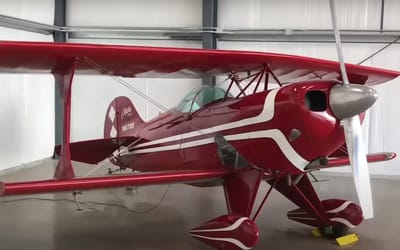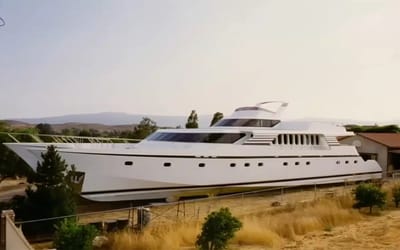Why commercial planes are still so similar to those built 50 years ago
- Modern commercial planes are similar to those built over half a century ago
- That’s partly due to seats being squeezed in to accommodate more paying passengers
- But what does the flying experience of the future look like?
Published on Jun 11, 2024 at 6:40 PM (UTC+4)
by Amelia Jean Hershman-Jones
Last updated on Jun 13, 2024 at 6:26 PM (UTC+4)
Edited by
Tom Wood
While phones, computers, and cars have advanced by light years in the 50 years, here’s why commercial planes are so similar to those built over half a century ago.
Stats suggest that 4.46 billion passengers flew in 2019 – with figures taking a steep drop during the 2020 pandemic, whereas in 1970 that figure was a mere 310 million.
However, with the exception of less legroom, tiny TV screens, and more cramped conditions anywhere bar First Class – the design of commercial planes remains the same.
READ MORE! The world of private jets: types, costs, and ownership options
Why are commercial planes unchanged?

The reason for airline-cabin being designed as stagnant as the air is simply: it all comes down to money.
While airplanes focus their attention on other aspects of commercial airplanes, cabin design takes a back – and pretty cramped – seat.
Conversely, classic Pan Am flights featured bars and lounges, with passengers flying in comparison.
Now airlines have reduced legroom, aisle width, the size of the toilet, and space for cabin baggage, in favor of squeezing in more seating.
More seats equate to more paying passengers – but it also means more weight.
Most modern airline companies focus their investment on the overall weight of the plane rather than interior design.
How to make commercial planes lighter



While metal is a requirement to withstand the speed of jet-powered flight, planes need to be made of light materials to get off the ground.
Aluminum and titanium were once used, however metallics are now being dropped in favor of carbon fiber-reinforced plastic composites.
Composites are more expensive than metal, but unlike aluminum, they don’t corrode.
Boeing and several other aerospace companies are exploring polymers and ceramics to construct aircraft.
While matching metals and composites on strength – they’re far lighter.
The bonus: this also boosts a plane’s fuel efficiency.
Aside from weight, airlines are spending large sums of money on lean-burn engines, to lower the carbon footprint and, of course, save money on fuel.
The future of commercial planes


But while things haven’t changed yet, there is evolution on the horizon.
Longer haul flights, for example, are forcing change.
It’s hoped that by September 2024, Air New Zealand will be introducing its ‘Skynest’ concept to its Boeing 787 fleet of jets.
With a set of six bunk beds sitting in economy class, travelers who don’t have money to burn can experience a more comfortable flight – arriving at their destination refreshed and ready to go.
German airline, Lufthansa, is also targeting the economy experience – as well as passengers in premium economy, business, and first class.
In short, there will be a choice of 14 seat types.
These range from beds with closeable privacy doors to adjustable seats that won’t upset your rear neighbor.
Here’s the most exclusive premium first-class cabin returning to US air travel.
In a land down under, airline cabin designer, David Caon, is drawing up designs for a more homey cabin aboard Australian airline company, Qantas.
He spoke to The Telegraph, about his desire to get rid of overhead compartments in favor of easy-to-use seat-side storage.
And with 12 seats gone, there is space for a stretching and exercise area for economy passengers when the ‘Fasten seatbelts’ sign is switched off.
Want to see what lies beneath? Check out this mind-blowing footage exposing the true interior of a Boeing 737.
As a warning, you might not want to see.
For something a bit more calming and luxurious, this deep dive into private jet design and interiors reveals how they’ve evolved over the years.
DISCOVER SBX CARS: The global premium car auction platform powered by Supercar Blondie
All Supercar Blondie contributors undergo editorial review and fact-checking to ensure accuracy and authority in automotive journalism. After gaining her BA Hons in French and English at the University of Nottingham, Amelia embarked on a vocational diploma from the National Council for the Training of Journalists (NCTJ). This led to numerous opportunities, from interning at Vogue to being on the small team that launched Women’s Health magazine in the UK, which was named the PPA Consumer magazine of the year for three years running. As Health, Beauty and Fitness editor, Amelia personally received a Johnson & Johnson Award and was shortlisted for both PPA and BSME titles. Since then, Amelia has created content for numerous titles and brands, including the Telegraph, 111 Skin, Waitrose, Red magazine, Stylist, and Elle, as well as being Head of Content at Vitality and Editor in Chief at INLondon magazine. “My superpower is translating technical jargon about the mechanical workings of a supercar into a relatable story you’ll want to share with your friends after you’ve read it.” After joining the SB Media family as a senior journalist in September of 2023, Amelia’s role has evolved to see her heading up the SEO output of the editorial team. From researching the most ‘Google-able’ key terms to producing evergreen content - it’s been a time of hard work, growth, and success for the editorial team and the Supercar Blondie website. “I like to think of myself as a ‘method journalist’. In other words: I live and breathe whatever I am writing about. When writing about fitness, I trained as a personal trainer, and as a beauty editor, I completed an ‘expert’ in scent diploma with the Fragrance Foundation. “During my tenure at Supercar Blondie, however, I did something I never thought possible: I passed my driving test at the age of 36. One day I’d love to train as a mechanic to better understand what happens under the hood, too. “My sweet spot is providing readers with a ‘takeaway’ (read: something new they didn’t know before) after reading every one of my stories. While I don’t claim to be an expert in the automotive world, I know the experts and bodies in the field to rely on to provide our readers with an informative and thought-provoking story every time they visit the site.”




